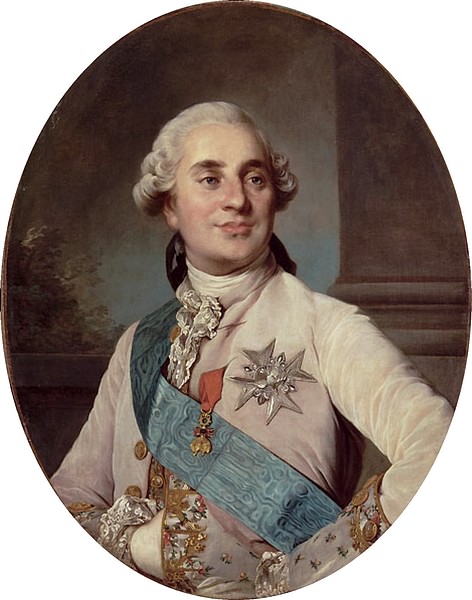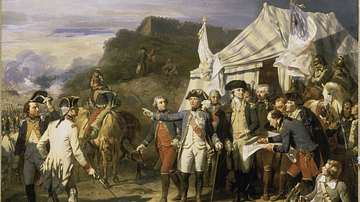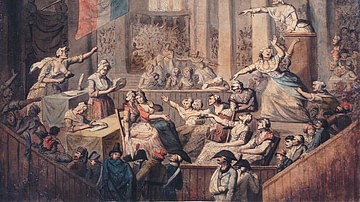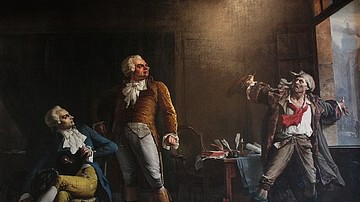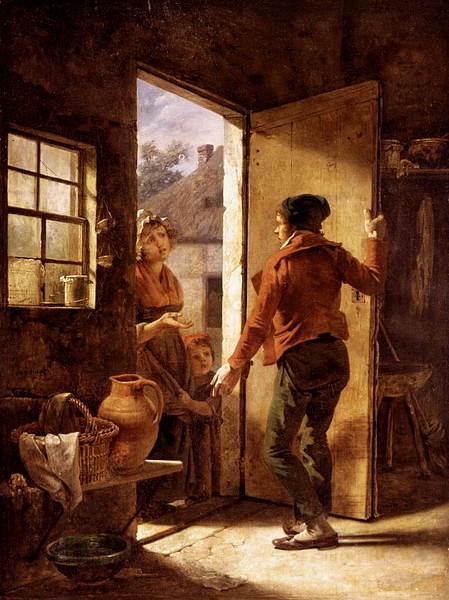
The Flour War refers to the series of approximately 300 riots that swept through France from April to May 1775, because of rising bread prices. The revolts only subsided after soldiers had been deployed, resulting in hundreds of arrests. It was one of the first physical manifestations of the crises that led to the French Revolution (1789-1799).
The price of bread was of the utmost importance to the French lower classes in the twilight years of the Ancien Régime. Bread made up three-quarters of most ordinary peoples' diets, and even in normal times, the poorest of workers might spend up to half of their income just on bread. Even modest increases in bread prices, therefore, threatened many with the prospect of starvation, making sudden rises in prices the most dangerous moments for public order. The Flour War itself was sparked when French Controller-General Anne-Robert Jacques Turgot (1727-1781) abolished control on the price of bread, believing in laissez-faire, a hands-off approach to the economy. This decision and a famine in 1774 led to rising bread prices, causing riots to break out.
Although bread supply did stabilize following the Flour War, the riots were one of the first major unrests tied to the issues that would cause the French Revolution. During the Revolution itself, bread riots would become a common form of protest and would lead to key revolutionary moments such as the Women's March on Versailles in October 1789.
Background: The Unalienable Right to Bread
By the 1700s, grain had become the most popular crop in France. Although there had not been any widespread, countrywide famines in the six decades prior to the 1770s, localized hunger was still an issue, and the fear of starvation had been enough to spark an obsession with the growing of grain. Other high-yield crops such as maize and potatoes were more rarely grown since these two crops required much more fertilizer than grain, which proved to be difficult in a time when most herds of livestock were neither numerous nor well-nourished enough to provide adequate manure. Aside from Alsace and Lorraine where potatoes were widely cultivated, many French peasants still considered potatoes to be unfit for animal consumption, let alone human, and refused to grow them.
The popularity of grain, combined with a lack of consistent access to meats in the lower classes, meant that bread made up a huge portion of ordinary peoples' diets. The lack of diversification in French agriculture also meant that the failure of harvests had a catastrophic effect. Although France had enjoyed many years of good harvests in the first half of the 18th century, from the late 1760s onward, harvests became more uncertain, and yields fluctuated sharply. Between 1770 and 1789, only three harvest seasons were abundant everywhere in France. With each new generation, peasant farmlands were divided up amongst the sons, so that by the late 1700s, many countryside farms were rather small, and therefore yielded unstable harvests.
The fear of famine prompted many French peasants to become protective over their access to bread. It was widely believed that the ability to feed oneself was a right that must be protected by the authorities. For this reason, the king of France had long been nicknamed "the first baker of the kingdom" and was expected to ensure that all his subjects had access to bread. If this right was not protected, such as in the case of bread prices rising beyond what most people could afford, many felt that it was their moral responsibility to act. This practice of ensuring that goods needed for survival were accessible to all would become known as a moral economy. Most people viewed this differently from outright thievery, as when prices rose too high, rioters who took bread or grain would often leave behind whatever price they felt was fair, a concept known as taxation populaire. Hoarding in times of difficulty was also seen as a cardinal sin; during the French Revolution, it was punishable by death.
Since the Middle Ages, this moral economy had been upheld by a series of regulations within the grain market, safeguarded by French authorities to guarantee accessibility to grain. These regulations included control on who could participate in the sale of grain and limitations in business transactions. Cultivators were prohibited from involving themselves any further within the grain market beyond selling the produce they had, for fear of certain entities becoming too powerful and monopolizing trade in any given region. For example, bakers could purchase enough grain to make their bread but were forbidden from reselling it. All trades had to be conducted in a public forum, and regulations ensured that bread prices remained fixed and never rose too high.
Turgot & the Physiocrats
King Louis XVI of France (l. 1754-1793) came to the throne in May 1774, wanting to be loved. Yet the Flour War, breaking out less than a year into the start of his reign and mere weeks before his coronation, proved to be a rough start to both the young king's rule and his popularity. The root of the Flour War can be found with one of Louis' first actions as King, the appointment of 47-year-old economist Anne-Robert Jacques Turgot as his Controller-General.
Turgot was a proponent of the economic theory known as physiocracy, which advocated for a laissez-faire economic system. Physiocrats believed that an individual would work harder for his or her own benefit compared to the benefit of others, and laborers would be more productive for more profit, which would benefit consumers by providing more of a supply for their demand. This natural economy was inherent in the law of nature and was intended by God. Regulations such as those in the grain market were standing in the way of this natural order and therefore had to go so that "the economy could breathe the pure and heady air of market exchange" (Schama, 81).
Physiocratic measures had been taken in the 1760s when the ministers of Louis XV of France (r. 1715-1774) had last removed grain regulations. This was met almost immediately with shortage and localized riots in 1767 and 1768, and most regulations had been restored by 1770. Four years later, Turgot, faced with the enormous task of fixing the French economy, was still convinced that physiocracy could work in France. He believed that trade and manufacture would flourish under this system, and so, on 13 September 1774, Turgot abolished regulations and announced a free trade in grain.
The Flour War
Turgot's edict was poorly timed, coming about just before the poor grain harvest of 1774. Although Turgot had been made aware of the unfavorable harvest conditions as early as August 1774, he had been unwilling to postpone his decree. The harvest had not been equally poor in every region of France; consequently, many merchants, no longer inhibited by grain regulations, began buying up the grain in areas that had fared better during harvest and selling them in harder-hit regions for marked-up prices. The attempt by these merchants to corner the market ensured that the food shortage issues of spring 1775 went from a problem affecting several regions to a countrywide emergency. For this reason, the ensuing Flour War became much more widespread than the riots of 1767-1768. The famine began to affect people quickly, and although the French government ordered food shipments from foreign countries, they would not arrive quickly enough.
On 15 March 1775, the first signs of unrest could be seen in Reims, the city that was preparing to host the coronation of Louis XVI the following June. Unnerved by the food shortage, a crowd of about 200 people formed outside a monastery, asking for reduced bread prices. The monastery doled out bread and the crowd dispersed without violence. A month later, as prices continued to spike, trouble broke out in the Burgundy region when a group of rioters sacked the home of a miller who had been accused of selling bad flour. When the miller went to hide in a friend's house, the rioters sacked the friend's house, too, before stopping a grain barge and forcing the merchants to sell their supply on the spot.
However, the Flour War only really kicked off in Beaumont-sur-Oise, a village in the Paris region. On 22 April, 1 setier (4.43 bushels) of wheat and rye grain was being sold for the high price of 26 livres in the village market. Villagers grumbled at such a price but still paid it if they could. Five days later, on 27 April, the market appeared to be well-stocked, and villagers believed that this would mean prices would have dropped. Far from receiving a discount, the villagers were shocked to see that grain was now being sold for 32 livres per setier. Outraged, arguments broke out between villagers and merchants, and the arguments soon flared into rioting. Rioters drove the merchants from their stalls and ransacked their displays. The rioters, adhering to taxation populaire, made sure not to steal the grain outright but to leave behind the amount of money they felt was the fair price to pay, which in this case was 12 livres per setier. After taking what they needed, the riot fizzled out on its own, and most people had gone home before the authorities had a chance to respond.
Early the next morning, 11 people from Beaumont-sur-Oise traveled to the town of Méru and told the townsfolk there what they had done. When the Méru market opened for business some hours later, the townsfolk followed their neighbors' example and rushed to pillage grain. The crowd, mostly made up of women, ripped sacks open with knives and scooped as much grain into their aprons as they could to carry home. Word of this riot spread as well, and the next day in the town of Pontoise, over a hundred people intercepted and ransacked several grain carts while also sacking the homes of six prominent grain and flour merchants.
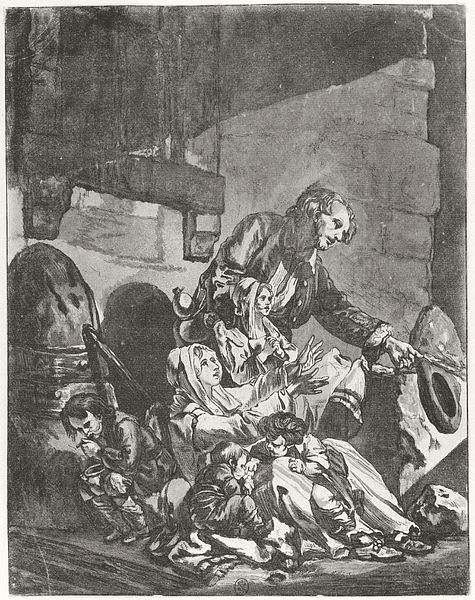
In the days following the initial riot on 27 April, similar uprisings spread to other towns throughout the Paris region growing in number and intensity by the day. As scholar Cynthia Bouton succinctly put it, "once lit, the conflagration spread rapidly and in many directions at once" (Bouton, 92). From relative confinement in the Paris Basin, the riots would spread north into Normandy. On 3 May, a particularly intense riot broke out in Vernon, Normandy, when rioters attacked an important grain and flour magazine. Like their compatriots in other French towns, the Vernon rioters demanded lower prices, and when they started to become violent, the magazine's clerk closed and locked the door, refusing further sales. The rioters then began to attack the locked doors with scissors, knives, and even sledgehammers. They refused to stop, even after the police arrived, who responded by firing into the crowd and wounding 6 people. This only enraged the crowd further, and they threw stones at windows and assailed three mills before finally dispersing.
By 6 May, the daily riots hit their peak, reaching 14 markets and 42 separate villages on that day. Trouble had begun to boil into the countryside as well, with some brigands invading and ransacking lands belonging to simple farmers. These attacks were the exception, however, as most of the rioters focused their efforts and anger on profiteers, such as rich millers or members of parlements. Many rioters still adhered to taxation populaire and continued to leave behind 12 livres per setier even as they ransacked merchants' stalls. By 11 May, most of the riots had run their courses.
Riots in Versailles & the Crown’s Response
On 2 May, four days before the peak of the Flour War, it was reported to the king that thousands of rioters were marching on Versailles. Although a story later circulated that Louis XVI bravely opened the gates of Versailles to the rioters, faced the crowd upon a balcony, calmed them with sympathetic fatherly words, and he was met with joyful shouts of Vive le Roy! (Long live the King!), this chain of events is unlikely. Police records seemed to indicate that not only did the royal family evacuate Versailles for the safety of Fontainebleau, but the rioters were not even heading for the palace. Instead, they made for the royal flour stores.
The royal stores contained over 900 sacks of flour, some of which were periodically shipped to bakers as far away as Paris. 5,000 rioters managed to pillage half of these sacks before royal guards arrived to disperse them. To get the rioters to go home without violence, and fearful that they may still attack the palace itself, the Prince de Poix, military governor of Versailles, hastily promised to lower the price of flour to 2 sous a pound. This worked to lull the crowds, but news of this new discount quickly spread throughout Paris. The Prince de Poix was later reprimanded by Turgot for undermining his edict.
At 8 am on 3 May, rioters from villages surrounding Paris entered the city and raided hundreds of bakeries. Before now, Parisian authorities had taken few courses of action; the lieutenant-general of the police, Jean-Charles-Pierre Lenoir, had only alerted the watch but had posted no guards and deployed no troops, despite multiple towns in the Paris region undergoing riots. Only after the Parisian riots on 3 May did French authorities muster a coordinated response. In the following days, around 25,000 soldiers were mobilized, some of them sent to patrol the countryside while others guarded marketplaces and bakery doors. Under the protection of the soldiers, the police were then free to start arresting suspects.
Hoping that things would calm down in Reims in time for the king's coronation, Turgot ordered the mobilization of charity workshops in the city and along the route to Paris to provide disgruntled commoners with work. On 5 May, Louis XVI officially called for a swift and severe repression of the riots, and on 9 May, he offered a general amnesty to all rioters who returned their stolen goods in kind or in cash, except for any leaders or instigators. Because of the Crown's response as well as a general loss of momentum, the Flour War was over before 11 June 1775, the date of Louis XVI's coronation, although unrest remained high throughout the summer before the supply recovered.
Aftermath & Legacy
Just as the king promised, the government's crackdown on Flour War rioters was indeed severe, at least when compared to previous, smaller-scale food riots. In previous riots, arrests usually only numbered in the dozens, with few prosecutions and light punishments. In the days following the Flour War, police arrested 548 people for their roles in the disturbances, 92% of the arrests taking place in the Paris region. French authorities sought out leaders and instigators to make examples out of, few of whom denied their involvement. Of the convicted riot leaders, two were condemned to hang, 15 to servitude as galley slaves (five of these were life sentences), and nine received sentences to royal prisons.
Turgot saw the riots as an attack against his position and the very concept of physiocracy itself. Pamphlets attacking his edicts circulated throughout the kingdom that summer, causing Turgot to see enemies everywhere and become convinced that the Flour War was nothing more than an elaborate conspiracy, where people were pretending to be hungry to embarrass him and his policies. Many of those arrested were subjected to interrogations about this supposed conspiracy to undermine free trade, but such interrogations revealed nothing. Turgot tried to save face by shifting the blame, calling for and receiving the resignation of Lieutenant-General of Police Lenoir, but it was clear his physiocratic experiment had failed for the time being. A year later, Turgot himself would be fired from the king's cabinet, for a variety of different reasons.
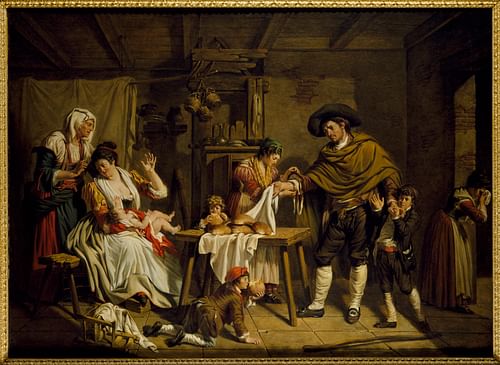
Although Louis XVI tried to show solidarity with the poor by eating the lower-class maslin bread, a mix of wheat and rye, rather than the elite manchet white bread, many still blamed him for the food shortages. Some even adopted the Pacte de Famine conspiracy theory, which claimed that the king and other interest groups were purposely withholding grain from the masses in order to better control them. While the lower classes blamed the king, the upper classes blamed the riots on the moral decadence of the poor, believing that the poor desired chaos for chaos' sake. The social tensions exacerbated by the Flour War would only deepen over the course of the next decade.
The Flour War was by no means the first, nor the most important food riot of the 18th century. It was a relatively bloodless affair, apart from the two executions, and did nothing to change the status quo. Yet coming so soon after the ascension of Louis XVI, the Flour War seemed to be one of the first warning signs that there was deep unrest not only in pockets of France but across much of the kingdom. In the succeeding years, as harvests failed to improve, bread riots would become more common, with one breaking out in the southern provinces in 1778, as well as in Normandy in 1784 and again in 1785. It could be said that the Flour War was therefore akin to the first drizzle of rain preceding the coming storm that was the French Revolution.


